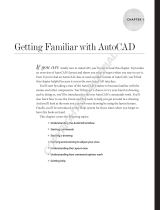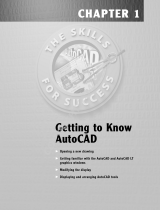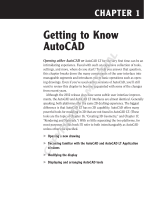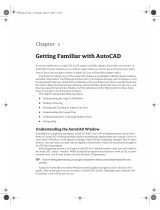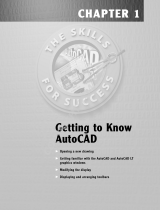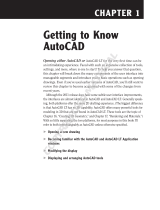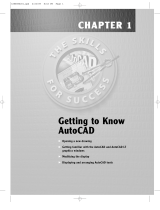Page is loading ...

Getting Familiar with AutoCAD
Chapter 1
If you are totally new to AutoCAD, you’ll want to read this chapter. It
provides an overview of AutoCAD’s layout and shows you what to expect when you start
to use it. Even if you’ve had an AutoCAD class or used an older version of AutoCAD,
you’ll find this chapter helpful because it covers the new AutoCAD interface.
You’ll start by taking a tour of the AutoCAD window to get familiar with the menus
and other components. You’ll then get a chance to try your hand at drawing, and in doing
so, you’ll be introduced to the way AutoCAD’s commands work. You’ll also learn how to
use the Zoom and Pan tools to help you get around in a drawing. And you’ll look at the
ways you can view your drawing by using the layout feature. Finally, you’ll be introduced
to the Help system for those times when you forget to have this book on hand.
This chapter covers the following topics:
Understanding the AutoCAD window
Starting a drawing
Panning and zooming to adjust your view
Understanding the Layout view
Understanding how command options work
Getting help
60609c01.indd 1 3/19/08 6:12:35 PM
COPYRIGHTED MATERIAL

2 ■ Chapter 1: Getting Familiar with AutoCAD
Understanding the AutoCAD Window
Autodesk has completely redesigned AutoCAD 2009’s interface. If you’ve used AutoCAD
before, it will appear as though AutoCAD has completely changed.
Don’t worry; the underlying program still behaves in much the same way as before.
Through AutoCAD’s workspace feature, you can easily change AutoCAD’s interface to
display the old, familiar toolbars that are seemingly missing from this latest version.
You’ll get a chance to look at workspaces later in this chapter. In this section, you’ll look
at AutoCAD’s newest interface options.
AutoCAD works like most other Windows-based graphics programs, but it also has a
few quirks. This section gives you an overview of AutoCAD’s layout. Although many ele-
ments will be familiar, a few will be new to you.
To start, you’ll see the two ways that AutoCAD displays a drawing. Then, for the rest
of this chapter, you’ll focus on the 2D drawing environment. After installing AutoCAD,
take the following steps to get to the 2D workspace:
1. Choose Start
➔
All Programs
➔
Autodesk
➔
AutoCAD 2009
➔
AutoCAD 2009. (LT
users will click AutoCAD LT 2009 in place of AutoCAD 2009 in the previous menu
selection.) You can also double-click the AutoCAD 2009 icon on your Windows
Desktop.
The opening greeting, called a splash screen, appears momentarily; then, if this is a
new installation, AutoCAD displays the Workspaces message box. This message box
offers an option to select 2D Drafting & Annotation, 3D Modeling, or AutoCAD
Classic.
2. Click 2D Drafting & Annotation. You’ll see the AutoCAD window with a blank
default document named Drawing1.dwg, as shown at the top of Figure 1.1. If this is a
new installation, you will also see the New Features Workshop window. If this hap-
pens, select Maybe Later, and then click OK.
AutoCAD 2009 versus AutoCAD 2009 Lt
AutoCAD 2009 and AutoCAD 2009 LT are essentially the same programs, with some differ-
encesboth large and small. The LT version has limited 3D capabilities and no 3D workspace.
Customization features too are limited in the LT version. With the exception of the 3D fea-
tures, you should be able to use the features discussed in this book when using AutoCAD
2009 LT.
The ↵ symbol in this book denotes the Enter key. Whenever you see it, press the Enter key,
also known as the Return key.
60609c01.indd 2 3/20/08 9:10:16 AM

Understanding the AutoCAD Window 3
3. The default document appears to be an empty 2D space. You’ll also see a special tool
palette, called the Ribbon, along the top, as shown in Figure 1.1. This is a set of 2D
drafting and annotation tools that gives you ready access to the most common draft-
ing functions.
If you are using AutoCAD 2009, try the following exercise to see how to get to the 3D
Modeling workspace (this workspace is not available in AutoCAD 2009 LT):
1. In the lower-right corner of the AutoCAD window, you’ll see a gear-shaped
icon. This is the Workspace Switching tool. Click it to open a list that shows
2D Drafting & Annotation, 3D Modeling, and AutoCAD Classic.
Figure 1.1
AutoCAD when
opened into a 2D
Drafting & Annota-
tion workspace
InfoCenter Quick Access Toolbar
Menu Browser
Ribbon
Drawing area
UCS
Command window
Status bar
In some installations, you might see a Startup dialog box. If this happens to you, click Cancel,
and AutoCAD will display the blank default document.
If this is a completely new installation, you might see the Autodesk Impressions toolbar in
the middle of the AutoCAD window. Autodesk Impressions, an adjunct program to Auto-
CAD, enables you to edit your drawings using tools similar to those found in Adobe Illustra-
tor. You can close this toolbar; I will not discuss this Autodesk product in this book.
60609c01.indd 3 3/19/08 6:12:37 PM

4 Chapter 1: Getting Familiar with AutoCAD
2. Select 3D Modeling from the list. (Notice that this list contains the same three
options found in the Workspaces message box that appears in step 1 of the previous
procedure.)
The current default file, Drawing1.dwg, is set up for 2D drafting, but you can open a
new file by using a file template already set up for 3D modeling.
3. On the Quick Start menu bar, click New. The Select Template dialog box appears.
Click New in the Quick Start menu bar
The Select Template dialog box appears
4. Select acad3D.dwt from the list, and click Open. A new file, called Drawing2.dwg,
appears. Notice that this drawing is in a 3D space. You’ll learn more about 3D mod-
eling in Chapter 6.
If you’re feeling adventurous, you can go to Chapter 6 to find out more about AutoCAD’s
new 3D tools. LT users will not have the 3D functions.
60609c01.indd 4 3/19/08 6:12:38 PM

Understanding the AutoCAD Window 5
5. Click the Workspace Switching tool, and click 2D Drafting & Annotation in the
Workspaces toolbar. You’ll be working in this workspace for most of this book.
6. Exit the 3D Drawing2.dwg file by clicking the Close icon in the upper-right corner of
the drawing area. The Close icon looks like an X.
Even though the default 2D file looks completely different from the new 3D file you
created by using the acad3D.dwt template, they really are basically the same. They just
have different display settings turned on. You can learn more about the different ways to
display drawings in Chapter 6.
You now have AutoCAD set up for 2D drawing, so you’ll take a more detailed look at
the AutoCAD window. You’ll find that, for the most part, it is a typical Windows-style
graphics program window with a few twists.
Getting to Know the Window Components
The AutoCAD window offers several controls to the program:
Ribbon•
Quick Access Toolbar•
Menu Browser•
Drawing area•
60609c01.indd 5 3/19/08 6:12:39 PM

6 Chapter 1: Getting Familiar with AutoCAD
Status bar•
Command window•
InfoCenter•
Your AutoCAD window should look like the earlier Figure 1.1, which shows the
default configuration for a new AutoCAD installation. Since AutoCAD is so easy to cus-
tomize, you might not see exactly the same layout, but the basic components should be
there.
AutoCAD 2009 offers the Ribbon that contains most of the common functions you’ll
need to use (see Figure 1.2). The Quick Access Toolbar offers the most commonly used
Windows functions, such as Save, Undo, Redo, and Print.
The Ribbon contains several panels, each of which contains tools for drawing and
editing. The set of panels changes depending on which Ribbon tab is selected. The Rib-
bon panels can be moved with a click and drag of their title bars, and the entire Ribbon
can be set up to stay hidden until you need to use it. You’ll learn more about these fea-
tures a bit later in this chapter.
When Ribbon panels are away from the edge of the window and appear “free float-
ing,” they are said to be floating, as opposed to docked.
If you click the AutoCAD logo in the upper-left corner of the window, you open the
Menu Browser, which gives you a more conventional menu structure for finding Auto-
CAD functions with a few additional features (see Figure 1.3).
At the top of the Menu Browser, you see the Search tool. This enables you to find a
specific tool by name just by typing the name into the search input box. At the bottom
of the Menu Browser, you have three options: Recent Documents, Open Documents,
and Recent Actions. If you point to Recent Documents, the panel to the right lists the
most recent files you’ve opened. Each file has a pushpin icon to the right, enabling you
to lock the item in the list. If you point to Open Documents, you’ll see a list of docu-
ments that are currently open in AutoCAD. The Recent Actions option lists the last few
actions you’ve taken using the Menu Browser. You can repeat an action by selecting it
from the list.
Figure 1.2
The Ribbon and its
components
InfoCenter
Quick Access Toolbar
Ribbon tabs
Ribbon
panels
Ribbon panel
title bars
60609c01.indd 6 3/19/08 6:12:40 PM

Understanding the AutoCAD Window 7
In the middle of the AutoCAD window is the drawing area where you’ll do your actual
drawing. At the bottom of the screen is the status bar, which provides information about
many of the settings you’ll use in AutoCAD. The status bar also offers controls over many
of the different drawing modes in AutoCAD. Just above the status bar is the command
window, which is almost unique to AutoCAD.
The command line is a text window that displays commands as you use them, as well
as your keyboard input. Messages often appear here that prompt you to perform a step in
a command. You’ll learn more about the command line a bit later in this chapter; see the
“Using the Command Line” section.
In the upper-right corner of the AutoCAD window you’ll see the InfoCenter. This is
where you can get help about AutoCAD feature or find current information about Auto-
CAD on the Internet.
Another unique item in AutoCAD’s window is the set of tool palettes shown in Fig-
ure 1.4. You can use these palettes to keep your favorite tools and drawing components in
one convenient place for quick access.
Figure 1.3
The Menu Browser
Click the AutoCAD icon to open the Menu Browser
60609c01.indd 7 3/19/08 6:12:41 PM

8 Chapter 1: Getting Familiar with AutoCAD
The Properties palette shown on the left and the AutoCAD tool palettes shown on the
right of Figure 1.4 might not appear in your AutoCAD window by default, but you can
open the tool palettes by clicking the View tab in the Ribbon and selecting Tool Palettes
from the Palettes panel.
The drawing area, the status bar, and the
command line work together to give you feed-
back while you create and edit your drawing.
As you move your cursor over the drawing area,
you’ll see the cursor appear as a crosshair cursor.
If you click the drawing area, a pair of numbers
and a selection window appear. Click again, and
the selection window disappears.
With the crosshair cursor, you can point to
portions of the drawing area, and the numeric display, known as the Dynamic Input dis-
play, tells you your XY coordinate within the drawing area. The selection window lets you
select objects in the drawing area. You’ll learn more about coordinates in AutoCAD in
Chapter 2, and you’ll look at selection windows a bit later in this chapter.
If you don’t see the Dynamic Input display, go to the status bar at the bottom of the
AutoCAD window, and click the Dynamic Input tool.
Figure 1.4
The Properties
palette (at left) and
the tool palettes (at
right)
Properties palette
Tool palettes
Tool palettes
View tab
60609c01.indd 8 3/19/08 6:12:42 PM

Understanding the AutoCAD Window 9
Along with the Dynamic Input display, the command line and status bar just below
the drawing area provide feedback as you work with AutoCAD commands (see Fig-
ure 1.5). You can also see the XY coordinate in the far left of the status bar in the lower-
left corner of the AutoCAD window.
ControLLing the status Bar DispLay
To the far right of the status bar, you’ll see a downward-pointing triangle, or arrow; click this
arrow to open a menu that controls the display of the status bar. You can also just right-click
in a blank area of the status bar to display this menu. You use this menu to turn the items in
the status bar on or off. A check mark by an item indicates it is currently on.
If for some reason you do not see all the buttons mentioned in the preceding discussion,
check this menu to make sure that all the status bar options are turned on. Note that the LT
version does not have an Otrack option in the status bar.
Using the Ribbon
If you’ve used the latest version of Microsoft Office for Windows Vista, you’ll be familiar
with the Ribbon. The Ribbon is a bit like a super toolbar that offers quick access to the
most commonly used tools. In addition, the Ribbon offers a lot of helpful information in
the form of expanded tooltips.
Specifically, the Ribbon is a collection of tools that invoke commands. These tools
are grouped into several tabs. Each tab contains a set of panels, and each panel contains
a set of icons representing tools and showing their function (see the earlier Figure 1.2).
The tools also offer tooltips that provide a lot of information, including a description that
helps you understand what the icons represent.
If you move the cursor onto one of the Ribbon panel tools and leave it there for a
moment, you’ll see a tooltip appear just below the cursor, giving you a brief description
of the tool. Leave the cursor there a bit longer, and the tooltip expands to show even
Figure 1.5
The status bar and
the command line
work with the draw-
ing area to give you
feedback as you
draw.
Command line
Coordinate readout
If the Ribbon does not appear on the screen, you can click in the command window and
then type ribbon↵ to restore it to the window.
60609c01.indd 9 3/19/08 6:12:44 PM

10 Chapter 1: Getting Familiar with AutoCAD
more information on how to use the tool (see Figure 1.6). As a new user, you’ll find these
tooltips very helpful.
Throughout the book, when I ask you to select a tool from the Ribbon or from a tool-
bar, I’ll use the name shown in the tooltip. For example, if you hover your cursor over
any icon tool in the Ribbon, you’ll see the name of the tool at the top of the tooltip that
appears (as shown in Figure 1.6).
In most cases, you’ll be able to guess what each tool does by looking at its icon. The
icon with an arc in the Draw panel of the Ribbon, for instance, indicates that the tool
draws arcs; the one with the circle shows that the tool draws circles; and so on. But for
further clarification, the tooltip gives you the name of the tool.
Finding Hidden Panels and Tools
In the next section, you’ll start to work in the drawing area by drawing some lines. Before
you do that, though, take a moment to examine the left part of the Ribbon, where the
Draw panel of the Ribbon resides. You will be instructed to use the tools in this Ribbon
panel frequently throughout this book, so it will be helpful for you to get a feel for their
arrangement and what they contain.
Besides the visible tools, a few tools are hidden from view. Click the Blocks and Refer-
ence tab just above the Ribbon. The row of Ribbon panels changes to a new set of panels.
Click the Home tab above the Ribbon to return to the previous set of panels.
As you work through exercises in this book, I’ll abbreviate the name of the Ribbon tabs to
simplify the instructions. For example, I’ll say “On the Home tab’s Draw panel” to refer to the
Draw panel on the Home tab of the Ribbon.
Figure 1.6
A tooltip showing
the name of
the tool, a brief
tutorial-like graphic,
and the command
name associated
with the tool
Context-sensitive help
Tool name
Description/tutorial
Keyboard command equivalent
60609c01.indd 10 3/19/08 6:12:45 PM

Understanding the AutoCAD Window 11
If you see a triangle on the right side of a Ribbon panel title bar, you can expand the
panel to reveal more tools. To do this, click the panel title bar. The panel will expand
downward. Once you click in the drawing area, the panel returns to its normal view. If
you want to lock the expanded panel so that it stays open, click the pushpin icon on the
right side of the expanded panel’s title bar.
Click the title bar to
expand the panel
Pushpin icon
You might also notice that some of the tools have triangular arrows next to them. You
can click these arrows to open flyout menus that contain options related to the tool with
which they are associated. For example, you can click the triangle next to the Circle tool
to open a flyout that offers different ways to draw a circle. You’ll get a chance to use these
features in Chapter 3.
Click the triangular arrow
to open the flyout
Switching to Floating Ribbon Panels
If you find that you use one particular Ribbon panel a lot, you can “tear off” the panel
and have it available as a floating Ribbon panel. To do this, click and drag the panel
title bar toward the drawing area. The panel’s appearance changes slightly to offer some
From now on, when you see the term expanded panel, you should expand the Ribbon panel
by clicking the panel’s title bar.
60609c01.indd 11 3/19/08 6:12:47 PM

12 Chapter 1: Getting Familiar with AutoCAD
controls (see Figure 1.7). These controls disappear when you are not pointing inside the
panel, but they reappear when you hover over the panel with your cursor.
Tooltips appear when you hover over the
controls, and they describe what each control
does. The last control, Toggle Orientation, is
a little misleading because it controls the dis-
play of the title bar.
Getting Familiar with the Drawing Area
As you might imagine, the drawing area in the middle of the AutoCAD window is the
space where you’ll be spending a lot of time. It pays to get a feel for how it behaves early
on. As your introduction to the drawing area, try the following exercise:
1. Move the cursor around in the drawing area. As you move the cursor, notice that the
coordinate readout in the status bar gives the X and Y coordinates and adds the Z
coordinate.
2. Click in the middle of the drawing area. You have just selected a point. Move the cur-
sor, and a rectangle follows. This is a selection window; if any objects appear in the
drawing area, you can select them for editing. A coordinate display appears at the
cursor, showing your coordinates in an X, Y format. Also notice the words Specify
opposite corner in the Dynamic Input display. This tells you that you have started a
selection window and you need to select the opposite corner for the window.
3. Move the cursor a bit in any direction; then click again. Notice that the selection
window disappears. Had there been objects within the selection window, they would
be selected. This is similar to the way the cursor behaves on the Windows Desktop;
however, in Windows, you have to drag the cursor to create a selection window.
4. Try selecting several more points in the drawing area. Notice that as you click, you
alternately start and end a selection window.
As you click the drawing area, you might notice that, depending on whether you click
to the right or to the left of the preceding point, the selection window displays a different
color. If you click from left to right, the selection window appears blue. From right to left,
it’s green. These colors indicate a different mode of selection, which you’ll learn about in
Chapter 4.
If you right-click, a shortcut menu appears. Just as with most other Windows applica-
tions, a right-click frequently opens a menu that contains options that are context sensi-
tive. This means that the contents of the shortcut menu depend on where you right-click
as well as on the command that is active at the time of your right-click. You’ll learn more
about these options as you progress through the book. For now, if you happen to open
this menu by accident, press the Esc key to close it.
Figure 1.7
A Ribbon panel in
its floating appear-
ance, showing its
controls
Close Panel
Toggle Orientation
Options
Send to Ribbon
60609c01.indd 12 3/19/08 6:12:49 PM

Understanding the AutoCAD Window 13
Finally, as with any window, you can expand the drawing area or contract it into a
smaller window by clicking the Restore Down icon in the upper-right corner of the draw-
ing area.
When the drawing area is in the Restore Down position, it appears as a separate win-
dow within the AutoCAD window. You can then resize the window to any rectangular
shape you need. This is helpful when you have multiple AutoCAD drawing files open.
To maximize a drawing to fill the AutoCAD window, double-click the drawing window
title bar.
Checking the UCS Icon
The UCS icon is the L-shaped icon you see at the lower-left corner of the drawing area
(shown earlier in Figure 1.1). It helps you see your orientation at a glance by pointing to
the positive X and Y directions. UCS stands for user coordinate system. That name is a
hint that you can create and use other coordinates besides the default one that exists in
new drawings. By default, the X direction is from left to right, and the Y direction is from
bottom to top; but with AutoCAD you can alter your view orientation as well as include
additional coordinate systems that can be oriented in different directions. The UCS icon
is especially helpful when you start to use these other coordinate systems and display
modes, but right now, just be aware that it is there to help you get your bearings.
You might notice a small square at the base of the UCS icon. This square tells you
that you are in the world coordinate system, which is the base coordinate on which other
coordinate systems can be built. You’ll learn more about the UCS in Chapter 5.
Using the Command Line
The horizontal window at the bottom of the AutoCAD window is called the command
window. Besides the drawing area, this is where you can get feedback from AutoCAD.
As you work in AutoCAD, the command activity appears in the bottom line of the com-
mand window and scrolls upward.
When AutoCAD is waiting for input, you’ll see the word
Command: at the bottom of the
command window. This is the command prompt. As you click a point in the drawing area,
you’ll see the message Specify opposite corner in the command line. Simultaneously, a
selection window appears in the drawing area. Click another point without selecting any-
thing; the selection window disappears, and the command prompt returns.
You’ll want to pay close attention to the command window as you start using Auto-
CAD because it tells you what AutoCAD expects you to do. It also lists information when
you query AutoCAD for certain types of information, which you’ll learn about in later
chapters.
In addition to getting feedback from the command window, you’ll also see the com-
mand prompt at the cursor whenever you have the Dynamic Input display turned on.
Minimize
Restore Down
Close
60609c01.indd 13 3/19/08 6:12:50 PM

14 Chapter 1: Getting Familiar with AutoCAD
The command window is a little like a chat window when you’re online. You “chat”
with AutoCAD by responding to messages that appear in the command line. When Auto-
CAD asks for specific data, the command line allows you to enter data using the keyboard.
It is also an area that provides information about your drawing when you request it.
“Chatting” with autoCaD
AutoCAD communicates its needs to you in messages in the command line. These mes-
sages often tell you what to do next or offer options, usually shown in
square brackets. Commands often display a series of messages, which
you answer to complete the command. If you aren’t sure what to do,
check the command line for clues.
As an additional aid, you can right-click to display a context-sensitive
shortcut menu. If you are in the middle of a command, this menu pro-
vides a list of options specifically related to that command. For example,
if you right-click before selecting the first point for the Rectangle com-
mand, a menu appears, offering the same options that are listed at the
command prompt, plus some additional options.
Using the Menu Browser
The command line is a little unusual for a Windows program, so the AutoCAD Menu
Browser provides a familiar means of finding commands. You can open the Menu
Browser by clicking the AutoCAD icon in the upper-left corner of the AutoCAD window
(shown earlier in Figure 1.3).
You can think of the Menu Browser as a menu bar that is oriented vertically, instead
of horizontally across the top of the window. If you’re familiar with Windows Internet
Explorer, you’ll find that the Menu Browser behaves much like the Favorites list. In fact,
the Menu Browser behaves like the tree view found in many navigation schemes.
what happeneD to the Menu Bar?
Earlier versions of AutoCAD had a horizontal list of options called a menu bar across the top
of the window. If you prefer to use the menu bar, you can turn it on by doing the following:
1. Right-click the Quick Access Toolbar.
2. Select Show Menu Bar.
The menu bar appears just below the Quick Access Toolbar. Note that the menu bar
does not offer the tooltips you find in the Menu Browser.
If you prefer to use the menu bar rather than the Menu Browser, you can still follow
the instructions in this book. Whenever I ask you to open the Menu Browser, just go to the
appropriate menu option in the menu bar instead.
60609c01.indd 14 3/19/08 6:12:50 PM

Understanding the AutoCAD Window 15
In the Menu Browser, you’ll see many of the standard Windows menu options, such as
File, Edit, Window, and Help, as well as a few that are specific to AutoCAD.
Another Menu Browser feature is the command description that appears as a tooltip
whenever you hover over a menu option. These descriptions often give enough detailed
information to get you started using the option. Try the following to see the tooltips
firsthand:
1. Open the Menu Browser, and click Modify. The list of items that appears includes the
commands and settings that let you control the way AutoCAD displays your drawings.
2. Move the cursor down the list of menu items. As you highlight each item, notice
that a tooltip appears. These tooltips help you choose the menu option you need and
in many cases give a kind of mini-tutorial on how to use the option. These tooltips
are the same as the ones you see with the Ribbon panel tools. Near the bottom of
the tooltip, you’ll see a single word in capital letters. This is the keyboard command
equivalent to the highlighted option in the menu (shown earlier in Figure 1.6). If you
prefer, you can actually enter these keyboard commands to start the tool or menu
item you have highlighted. You don’t have to memorize these command names, but
knowing them will help you later if you want to customize AutoCAD.
3. Some of the menu items won’t show a tooltip but will have arrows to their left. This
means the menu option has additional choices. For instance, click the Object option,
and you’ll see the list of options expand below the Object option. Click the Object
option again, and the list closes.
Opening Dialog Boxes
You might have noticed that other menu options are followed by an ellipsis (…). This
indicates that the option displays a dialog box, as the following exercise demonstrates:
1. Click the Tools option in the Menu Browser.
2. Click the Options item at the bottom of the
menu to open the dialog box (you might have
to use the scroll bar to the right of the Menu
Browser to get to the bottom of the list).
3. After you’ve taken a look at the Options dia-
log box, close it by clicking Cancel.
The Options dialog box is like the Preferences
dialog box in other programs. In it, you can find
most of the general settings that affect AutoCAD’s
behavior. Numerous settings are divided into
tabs across the top of the dialog box. The Options
dialog box is one of many dialog boxes available
through the menu bar.
60609c01.indd 15 3/19/08 6:12:51 PM

16 Chapter 1: Getting Familiar with AutoCAD
Starting Commands
Another type of item you’ll find in a menu is a command that directly executes an Auto-
CAD operation. Try this exercise to explore a typical command:
1. Click the Dynamic Input tool in the status bar to turn off Dynamic Input display
mode. When it is off, it is gray. You’ll start your exploration of commands with this
feature turned off so you can get a clear view of your activity. You’ll get a chance to
try the Dynamic Input feature in later chapters, starting with Chapter 2.
2. Click the Rectangle tool in the Draw panel. Notice that
the command line at the bottom of the window now
shows the following prompt:
Specify first corner point or [Chamfer/Elevation/Fillet/Thickness/Width]:
AutoCAD is asking you to select the first corner for the rectangle, and also, in brack-
ets, it is offering a few options that you can take advantage of at this point in the
command. Don’t worry about those options right now. You’ll have an opportunity to
learn about command options in Chapter 2.
3. Click a point roughly in the lower-left corner of the drawing area, as shown in
Figure 1.8. Now as you move your cursor, you’ll see a rectangle follow the cursor
with one corner fixed at the position you just selected. You’ll also see the following
prompt in the command line:
Specify other corner point or [Area/Dimensions/Rotation]:
Figure 1.8
Selecting the first
point of a rectangle
Click here to start the rectangle.
60609c01.indd 16 3/19/08 6:12:53 PM

Understanding the AutoCAD Window 17
4. Click another point anywhere in the upper-right region of the drawing area. A rect-
angle appears (see Figure 1.9). You’ll learn more about the different cursor shapes
and what they mean later in this chapter.
Next, try deleting the rectangle you just drew:
1. Place the cursor on top of the rectangle, but don’t do anything yet. Notice that as you
pass the cursor over the rectangle, it is highlighted. In a crowded drawing, this high-
lighting can help you determine exactly what will be selected when you click an object.
2. With the cursor on the rectangle and the rectangle highlighted, click the rectangle.
The rectangle is selected, and the Quick Properties dialog box opens. This dialog box
gives you access to the properties of the selected object.
3. Close the Quick Properties dialog box by clicking the X in its upper-right corner.
You’ll see a message box asking whether you want to “turn off the Quick Properties
panel for all future selected objects.”
4. Click the answer that says “Turn off for all
future selected objects.” You can easily restore
the Quick Properties panel feature at any time
by clicking the Quick Properties Panel tool in the status bar.
Figure 1.9
Once you’ve
selected the first
point of the rect-
angle, you’ll see a
rectangle follow
the motion of your
mouse.
You’ll learn more about the Quick Properties panel in Chapter 4.
60609c01.indd 17 3/19/08 6:12:55 PM

18 Chapter 1: Getting Familiar with AutoCAD
5. The rectangle is still selected, so press the Delete key to delete it. This removes the
rectangle from the drawing.
In step 1, AutoCAD shows you exactly what the cursor is pointing to by highlighting
objects that will be selected with the next click.
When drawing and erasing the rectangle, you were exposed to the most common pro-
cesses you need to know about to work in AutoCAD: you selected a command from the
menu bar, and then you selected points in the drawing area while following the messages in
the command line. Commands from the toolbars work in the same way, as you’ll see next.
unDerstanDing the CoMManD-tooL-option reLationship
One of AutoCAD’s greatest assets is its ability to adjust to your way of performing tasks. If
you prefer using toolbars, you can gain access to nearly all the AutoCAD functions through
toolbars. If you prefer using options from a menu bar, again, you can perform most of what
you need through them. And the Ribbon offers the most commonly used functions in Auto-
CAD. Experienced users know how to use the command line and know nearly all the com-
mands by heart.
The AutoCAD commands are really at the heart of its operations. Menu bar options,
the Ribbon, and the toolbar buttons are really just different ways to invoke AutoCAD com-
mands. When you click a toolbar button or a menu option, you are really initiating a com-
mand through AutoCAD’s menu system, sometimes with predetermined options already
selected. In fact, if you watch the command line as you click a menu option or toolbar but-
ton, you’ll see that the messages in the command line are the same regardless of where you
invoked the command.
For this reason, I’ll often intermix the terms tool, option, and command, because at a prac-
tical level they are really all the same. Just be aware that menu options and toolbar buttons
invoke commands.
Using Other Toolbars
If you are familiar with earlier versions of AutoCAD, you’ll remember that toolbars
were the primary method for using the many AutoCAD drawing and editing tools. The
toolbars are still available and can offer a quick way to get to the tools you need. Table 1.1
describes the toolbars that are available in AutoCAD.
Like the floating Ribbon panel, a toolbar will display its Close icon (the X in the upper-right
corner) when you hover over the toolbar with your cursor. Otherwise, the Close icon will be
hidden.
60609c01.indd 18 3/19/08 6:12:55 PM

Understanding the AutoCAD Window 19
Command desCription
3D Navigation Tools for controlling 3D views (not available in LT).
CAD Standards Tools for checking the layer, dimension, and text styles against standards you have
created (not available in LT).
Camera Adjustment Tools for controlling camera objects.
Dimension Commands for helping you dimension your drawings. Many of these commands are
duplicated in the Dimension drop-down menu. See Chapter 10.
Draw Commands for creating common objects, including lines, arcs, circles, curves,
ellipses, and text. This toolbar appears in the AutoCAD window by default. Many of
these commands are duplicated in the Draw drop-down menu.
Draw Order Commands for arranging the order of overlapping objects. If an object covers
another object that you need visible, you can use the Draw Order toolbar to “move”
an object behind another or to the back of a set of objects (not available in LT).
Find Text Input box and search text tool to help you locate text strings in a drawing.
Inquiry Commands for finding distances, point coordinates, object properties, mass prop-
erties, and areas.
Insert Commands for importing other drawings, raster images, and OLE objects.
Layers Drop-down list and tools, just below the Standard toolbar, for controlling layer
properties.
Layers II Additional tools for managing layers (formerly Express Layer tools).
Layouts Tools for setting up drawing layouts for viewing, printing, and plotting.
Lights Tools for adding and controlling lights in 3D models.
Mapping Tools for adding texture maps in 3D models.
Modeling Tools for creating and editing 3D objects.
Modify Commands for editing existing objects. You can move, copy, rotate, erase, trim,
extend, and so on. Many of these commands are duplicated in the Modify drop-
down menu.
Modify II Commands for editing special complex objects such as polylines, multilines, 3D
solids, and hatches.
Multileader Tools for adding leader notes to your drawing.
Object Snap Tools for selecting specific points on objects, such as endpoints and midpoints. See
Chapter 3.
Orbit Tools for controlling 3D views.
Properties Commands for a set of drop-down lists and tools for manipulating the properties of
objects. This toolbar is ordinarily docked to the right of the Layer toolbar, just below
the Standard toolbar.
Refedit Tools for making changes to symbols or background drawings that are imported as
external reference drawings (not available in LT).
Reference Commands for controlling the cross-referencing of drawings. See Chapter 8.
Render Commands for operating AutoCAD’s rendering feature (not available in LT).
Solids Editing Command for editing 3D solids (not available in LT). See Chapter 6.
Standard The most frequently used commands for view control, file management, and edit-
ing. This toolbar is ordinarily docked below the menu bar.
Standard Annotation An abbreviated version of the Standard toolbar.
Styles Tools for controlling style options such as text styles and dimension styles.
Text Tools for creating and editing text. See Chapter 9.
UCS Tools for setting up a plane on which to work. This is most useful for 3D modeling,
but it can be helpful in 2D drafting as well. See Chapter 6.
Table 1.1
AutoCAD Toolbars
continued
60609c01.indd 19 3/19/08 6:12:56 PM

20 Chapter 1: Getting Familiar with AutoCAD
Command desCription
UCS II Tools for selecting from a set of predefined user coordinate systems.
View Tools for controlling the way you view 3D models. See Chapter 6 for more on 3D
views.
Viewports Tools for creating and editing multiple views of your drawing. See Chapter 6 for
more about viewports.
Visual Styles Tools for controlling the way 3D models are displayed.
Walk and Fly Tools for controlling motion through a 3D model.
Web Tools for accessing the Web.
Workspaces Tools for managing workspaces.
Zoom Commands for navigating your drawing.
Opening toolbars is fairly simple, but unless you know where to look, you might never
find them. The following steps show you how to open the Draw toolbar:
1. To open the Draw toolbar, right-click the Quick Access toolbar in the upper-left cor-
ner of the AutoCAD window. A shortcut menu of options appears.
2. On the shortcut menu, choose Toolbars
AutoCAD
Draw. The Draw toolbar
appears in its docked position at the left side of the AutoCAD window. (Again,
docked just means the toolbar is merged with the border of the AutoCAD window to
keep it out of the drawing area.)
3. You can “undock” a toolbar by clicking and dragging the toolbar’s grab bar. The grab
bar is the dotted area you see at the top or left end of the toolbar. (Again, the toolbar
then is called a floating toolbar and shows its title bar.) In its floating position, you
can click the X in the upper-right corner of the Draw toolbar to close it.
You can dock toolbars at the top, bottom, or sides of the AutoCAD window to keep
them out of the drawing area.
If you do not want the toolbar to dock but instead want it to appear “floating” near the bor-
der of the AutoCAD window, you can press the Ctrl key before you click and drag the toolbar
into position. This prevents toolbars from automatically falling into a docked position.
AutoCAD remembers your toolbar arrangement between sessions. When you exit and
then reopen AutoCAD later, the AutoCAD window appears just as you left it.
continued
60609c01.indd 20 3/19/08 6:12:57 PM
/
